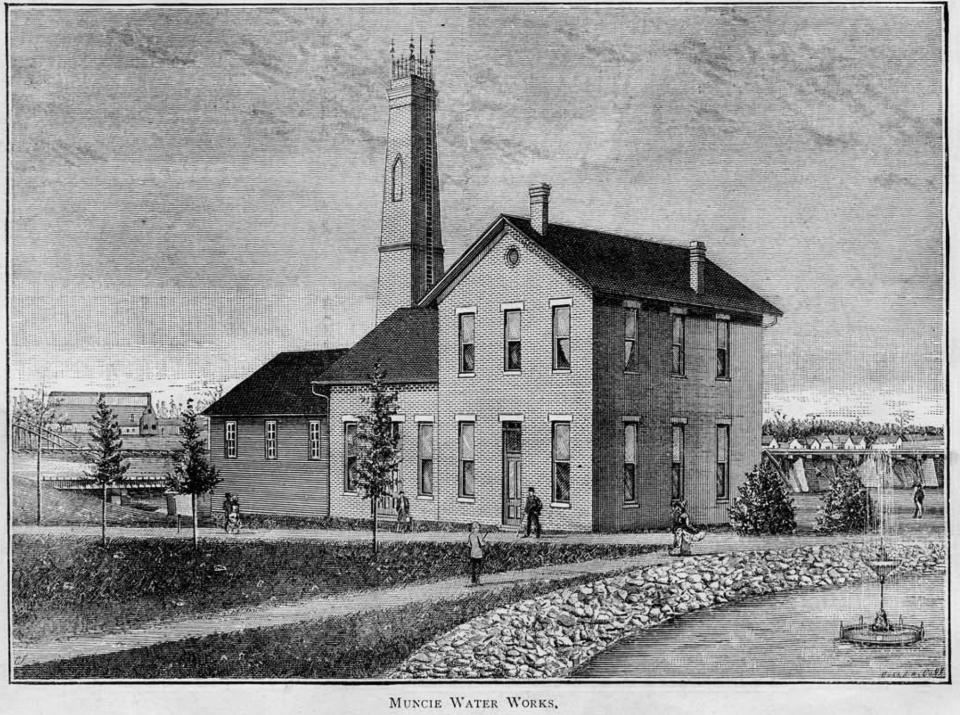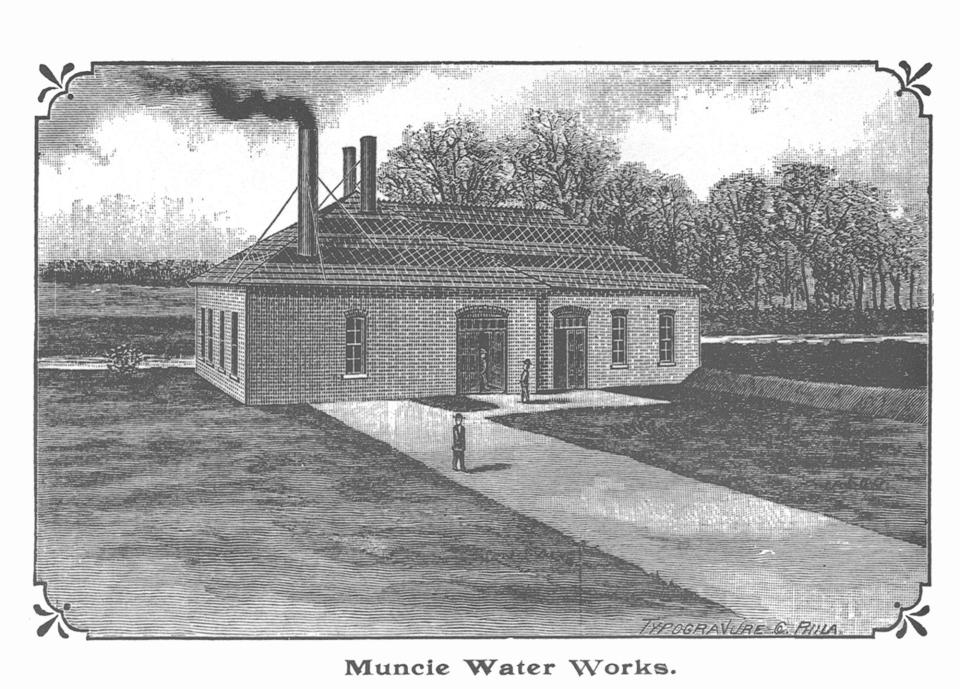ByGone Muncie: From whence the Waterworks came
A massive fire broke out in James Boyce’s East Washington Street flax mill on the morning of August 1, 1881. A spark in the power room ignited a dusty corner of cobwebs and spread to packing straw, sending the factory up in flames. The blaze engulfed Boyce’s adjacent handle factory and part of nearby Muncie Washer Company.

Muncie’s nascent fire department rushed to the scene with limited options. Like most Hoosier communities in 1881, our city didn’t have pressurized running water, ergo, no hydrants. Instead, the MFD deployed two horsedrawn, Babcock engines, which were basically giant fire extinguishers. Firefighters were aided by hundreds of Munsonians who helped salvage machinery and product in advance of the inferno.
The Muncie Daily Times reported that, for an hour, the firefighters “fought the fiery monster. Inch after inch was contested until finally the main building was saved,” but not before causing $18,000 in damages.
The Boyce blaze reignited a local debate about whether Muncie should establish a municipal waterworks. A few weeks after the conflagration, the Daily Herald called for one: “Muncie must grow and increase. And the first thing that we must have, if this is to be accomplished, is a first-class water supply.” The editorial concluded in all caps, “WE MUST HAVE WATER WORKS, AND HAVE THEM SOON.”

Though Muncie’s city council had begun exploring options a year earlier, the Boyce fire prompted immediate action. Council commissioned an engineer from Richmond named Frank Doran to draw up preliminary designs for a pressurized water system. Doran submitted his plan just before Christmas in ‘81. He recommended a water plant west of town, running at a capacity to serve up to 20,000 residents. Doran’s design allowed for growth, as Muncie’s population was only about 5,300 in 1881.
At the time, there was strong opposition to the plan. Some Munsonians didn’t want the tax increase, while others thought the city’s government lacked the necessary competence to run a water utility. Waterworks proponents, however, wanted clean drinking water, fountains, and pressurized water for fire hydrants.
Nathaniel Ethell, an aging settler and editor of the Muncie Morning News, captured the opposition’s sentiment in a January 1882 editorial. Ethell wasn’t opposed to a waterworks per se, but feared “long years of heavy taxation” and that Munsonians weren’t ready “to plunge into this vortex of debt.”
A year later, the city council commissioned another plan from J.D. Cook, an engineer from Toledo. Cook submitted his report in January 1884, which included costs and revenue projections. He argued that, though a tax increase was inevitable, the savings to Munsonian’s insurance premiums would offset the cost. The planned hydrants would drop rates for anyone owning property. Cook concluded, “The mitigation of loss from conflagrations, the reduction in insurance rates and in risks on uninsured property, the incentive to increase in manufactories, and corresponding increase in taxable valuation, greater sanitary safety, comforts, and luxury” would all benefit the city greatly.
On April 14 city council voted to establish a municipal waterworks, along with a sewer system. However, council abandoned the idea of a city-run water utility the following January in 1885. They passed a new ordinance “giving the Mayor and Clerk power to sign a contract for the erection of water works” with a private firm instead.
Mayor Frank Ellis signed with the newly formed Muncie Waterworks Company, with James and William Kuhn as chief operators and principal investors. The brothers had built a few other water companies back east. They knew Muncie well, as their father John owned and operated Muncie Gas Co., the city’s coal-gas streetlight utility. Pre-gas boom industrialists Theodore Rose and Abbott Johnson also had controlling stakes in the waterworks. The city paid $100,000 to build and contracted for twenty years at $5,000 per annum.
Muncie Waterworks adopted Cook’s plan, though the pump house was placed east of town about where South Brotherton Street meets the White River today. The facility went into operation in fall of 1885. The water was sourced from two wells and supplemented by the White River. Waterworks’ secretary Theodore Rose wrote that, in addition to saving Munsonians $2,500,000 in insurance costs, the “free use of water for public buildings and schools, flushing of streets and sewers, the increased fire protection, sanitary facilities, encouragement to manufactories, and beautifying our city by clean streets, green lawns, graceful fountains and beautiful flowers, all have a money value in the sale of property and the comforts of home.”
The discovery of natural gas unleashed an economic boom a year later, radically altering the trajectory of Muncie’s development. The population doubled between 1886-1890 as factories arrived en masse. The pollution became so bad that Muncie Waterworks abandoned their facility and built a new one a little up river along Burlington Drive in 1889. Indiana American Water operates from this same location today.
The historian G.W.H. Kemper wrote that the new facility sourced water from “flowing wells, driven about 200 feet into the fissured limestone…and from a filter gallery about 400 feet long on the bank of the White river.” By 1890, Muncie’s system was pumping watery goodness through 7 miles of pipe, feeding 85 hydrants.
The Burlington plant was modified many times in the 20th century. Extensive filtration was added in the 1910s. Then after the First World War, the distribution system expanded widely, allowing for affordable indoor plumbing. By the mid-1920s, Muncie’s waterworks was distributing about 3,000,000 gallons a day.
The Kuhns consolidated Muncie operations with their five other water companies in 1886 to form the American Water Works and Guarantee Company. The firm grew exponentially in the 20th century and eventually went public. Today we know them as American Water. The public utility, according to Google Finance, offers “water and wastewater service to approximately 1,700 communities in 14 states serving a population of approximately 14 million.” A 2021 Muncie water quality report indicated that American Water supplies Munsonians with 7.8 million gallons of water per day on average, sourced mostly from the White River and Prairie Creek Reservoir with a lesser percentage coming from four groundwater wells.
As far as utilities go, American Water is the best. The occasional algae bloom aside, the company has supplied Munsonians with quality water for 137 years. I just wish they’d paint MUNCIE on their two giant water towers. No need to advertise with your own logo, good sirs and madams, you have my business!
Chris Flook is a Delaware County Historical Society board member and a Senior Lecturer of Media at Ball State University
This article originally appeared on Muncie Star Press: ByGone Muncie: From Whence the Waterworks Came

